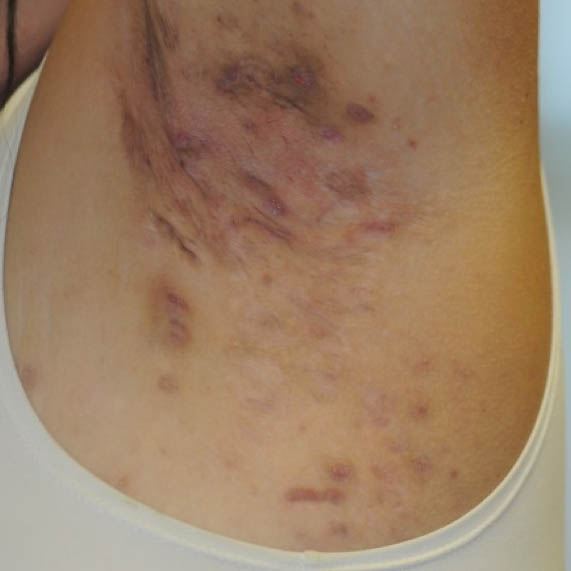Understanding Hidradenitis Suppurativa (HS)
Hidradenitis suppurativa (HS) is a skin disease characterized by painful lesions in sensitive regions of the body. HS can have debilitating physical and psychosocial effects, especially as the disease progresses.1,2
Although the disease has been historically referred to as acne inversa, Velpeau’s disease, Verneuil’s disease, or apocrine acne, today hidradenitis suppurativa, or HS, is the most widely accepted and used terminology.3

HS Hurley Stage II, axilla
Epidemiology of HS
PREVALENCE
Prevalence of HS is currently estimated at 0.1%-1.19% globally.4,5 While HS was once believed to be a rare disease, growing awareness and diagnosis rates suggest the disease is more prevalent than once thought.6,7
GENDER
Women are more commonly affected than men, with a ratio of 3 to 1.8
AGE
Symptom onset typically occurs between puberty and middle age—prevalence declines in those older than 50 years of age. In one survey, the mean age of HS disease onset was 20.5 years.8,9
Adolescent-onset HS may be more frequent than previously reported. Adolescents with HS may avoid seeking medical consultation due to fear, embarrassment, or assuming their symptoms are associated with puberty. Pain is often what pushes adolescents to eventually seek help.10,11
ETHNIC PROPENSITY
A population-based analysis of HS found that HS disproportionately affects African American patients—up to 3 times more than Caucasian patients.4
However, HS can occur in people of all ethnicities.12
GENETIC FACTORS
Up to 40% of patients report a family history of HS. HS seems to develop in genetically predisposed individuals whose immune system elicits an abnormal chronic inflammatory response.13,14
Cycle of Inflammation
Once thought to be caused by an infection or dysfunction of the apocrine glands, HS is now understood to be an inflammatory disease.1
Delays in Diagnosis
HS may be mistaken for other conditions, leading to delays in diagnosis and management.15
REFERENCES
1. Porter ML, Kimball AB. Clinical presentation of hidradenitis suppurativa. In: Kimball AB, Jemec GBE, eds. Hidradenitis Suppurativa: A Disease Primer. Switzerland: Springer International Publishing AG; 2017:9-18. 2. Alikhan A, Lynch PJ, Eisen DB. Hidradenitis suppurativa: a comprehensive review. J Am Acad Dermatol. 2009;60(4):539-561. 3. National Organization for Rare Disorders (NORD). Hidradenitis suppurativa. NORD website. https://rarediseases.org/rare-diseases/hidradenitis-suppurativa/. Accessed January 21, 2020. 4. Garg A, Kirby JS, Lavian J, Lin G, Strunk A. Sex- and age-adjusted population analysis of prevalence estimates for hidradenitis suppurativa in the United States. JAMA Dermatol. 2017;153(8):760-764. 5. Ingram JR, Jenkins-Jones S, Knipe DW, Morgan CLI, Cannings-John R, Piguet V. Population-based Clinical Practice Research Datalink study using algorithm modelling to identify the true burden of hidradenitis suppurativa. Br J Dermatol. 2018;178(4):917-924. 6. Micheletti RG. Hidradenitis suppurativa: current views on epidemiology, pathogenesis, and pathophysiology. Semin Cutan Med Surg. 2014;33(suppl 3):S48-S50. 7. Saunte DML, Jemec GBE. Hidradenitis suppurativa: advances in diagnosis and treatment. JAMA. 2017;318(20):2019-2032. 8. Jemec GBE. Hidradenitis suppurativa. N Engl J Med. 2012;366(2):158-164. 9. Garg A, Neuren E, Cha D, et al. Evaluating patients' unmet needs in hidradenitis suppurativa: results from the Global Survey Of Impact and Healthcare Needs (VOICE) Project. J Am Acad Dermatol. 2020;82(2):366-376. 10. Molina-Leyva A, Cuenca-Barrales C. Adolescent-onset hidradenitis suppurativa: prevalence, risk factors and disease features. Dermatology. 2019;235:45-50. 11. Data on file, AbbVie Inc. HS adolescent & caregiver: in-home immersions & virtual interviews. 2018. 12. Vaidya T, Vangipuram R, Alikhan A. Examining the race-specific prevalence of hidradenitis suppurativa at a large academic center; results from a retrospective chart review. Dermatol Online J. 2017;23(6). 13. van der Zee HH, Laman JD, Boer J, Prens EP. Hidradenitis suppurativa: viewpoint on clinical phenotyping, pathogenesis and novel treatments. Exp Dermatol. 2012;21(10):735-739. 14. American Academy of Dermatology (AAD). Hidradenitis suppurativa: who gets and causes. AAD website. Accessed March 16, 2020. https://www.aad.org/public/diseases/a-z/hidradenitis-suppurativa-causes.15. Lockwood SJ, Kimball AB. Diagnostic workup. In: Kimball AB, Jemec GBE, eds. Hidradenitis Suppurativa: A Disease Primer. Switzerland: Springer International Publishing AG; 2017:27-37.
